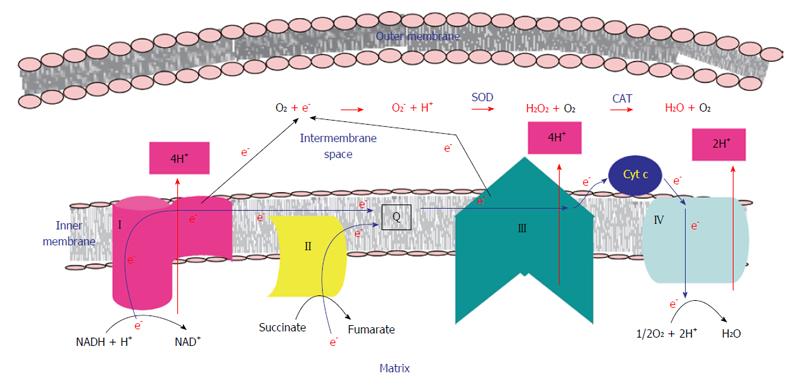Copyright
©The Author(s) 2016.
World J Biol Chem. Feb 26, 2016; 7(1): 110-127
Published online Feb 26, 2016. doi: 10.4331/wjbc.v7.i1.110
Published online Feb 26, 2016. doi: 10.4331/wjbc.v7.i1.110
Figure 2 Production of reactive oxygen species in mitochondria.
ETC enzymes such as I (complex I), II (complex II), III (complex III) and IV (complex IV) are shown to be located in the inner membrane of mitochondria. During electron transport in ETC, e-via complex I (from NADH) and via complex II (from FADH2) are passed to complex III through Q and then subsequently passed to complex IV. In the sequence, they are finally delivered to the reaction in which O2 is reduced to H2O. In coupled with the above process, protons are pumped to intermembrane space via complexes I, III and IV. This forms a chemiosmotic gradient to avail free energy for synthesis of ATP molecules via complex V enzyme (not shown in the figure). However, due to leakage of electrons at complex I and complex III enzymes during electron transport, O2 molecules are incompletely reduced to form ROS such as O2- anion radical, H2O2 and OH radical (formed due to the interaction between O2- and H2O2). Enzymes such as SOD and CAT catalyzes the reactions at the respective steps as shown in the figure. It leads to production of subsequent other ROS. Blue thick arrows indicate direction of flow of electrons in ETC. Red arrows indicate pumping of protons from matrix to intermembrane space. Black arrows indicate leakage of electrons to intermembrane space[40]. ETC: Electron transport chain; e-: Electrons; Q: Ubiquinol; O2-: Superoxide; H2O2: Hydrogen peroxide; OH: Hydrogen; SOD: Superoxide dismutase; CAT: Catalase.
- Citation: Paital B, Panda SK, Hati AK, Mohanty B, Mohapatra MK, Kanungo S, Chainy GBN. Longevity of animals under reactive oxygen species stress and disease susceptibility due to global warming. World J Biol Chem 2016; 7(1): 110-127
- URL: https://www.wjgnet.com/1949-8454/full/v7/i1/110.htm
- DOI: https://dx.doi.org/10.4331/wjbc.v7.i1.110









